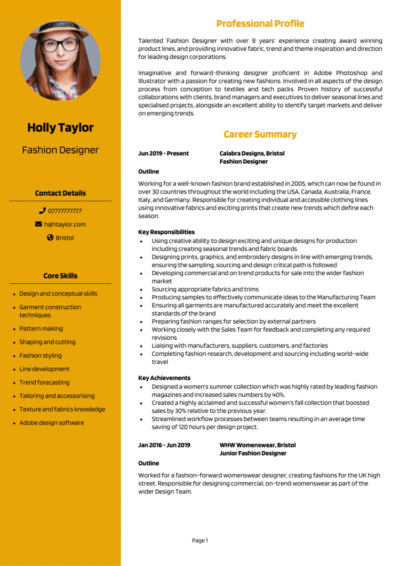You have a passion for design and the skills to bring creative concepts to life – but before you can make your mark in the fashion industry, your CV needs to be as stylish as your portfolio. If it looks more ‘fast fashion’ than ‘couture,’ recruiters might not give it a second glance.
If your CV is poorly structured or outdated, it won’t matter how visionary your designs are. This guide includes 4 Fashion Designer example CVs and plenty of tips to help you craft a polished application that gets interviews.
Fashion Designer CV
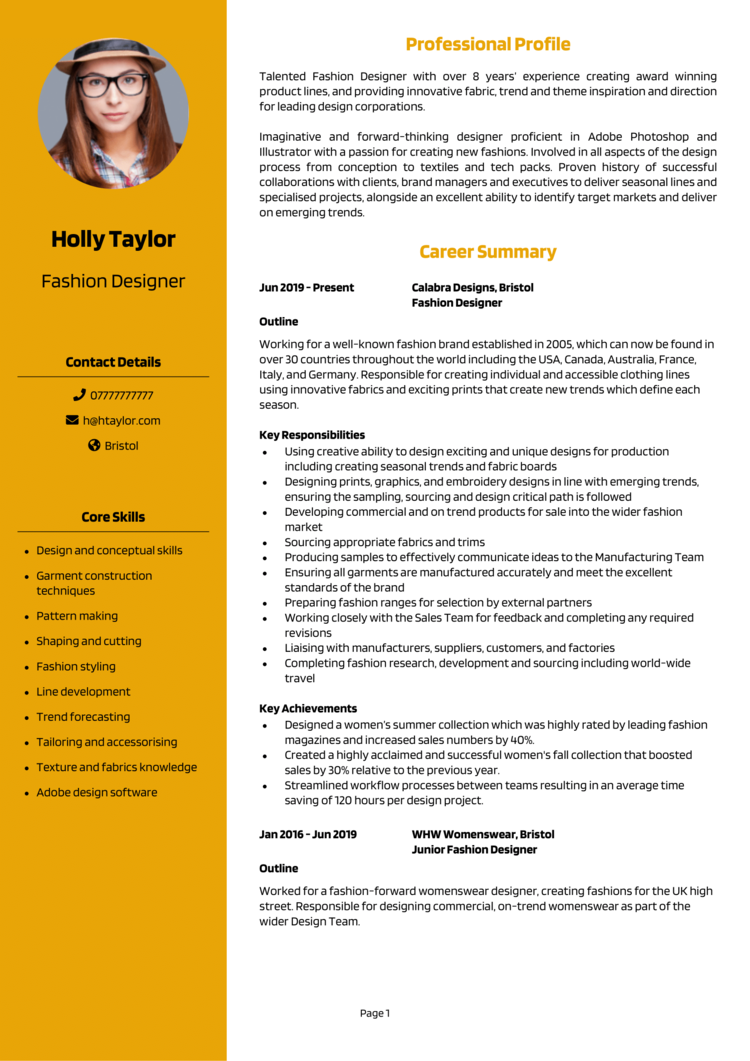
Fashion Design Student CV
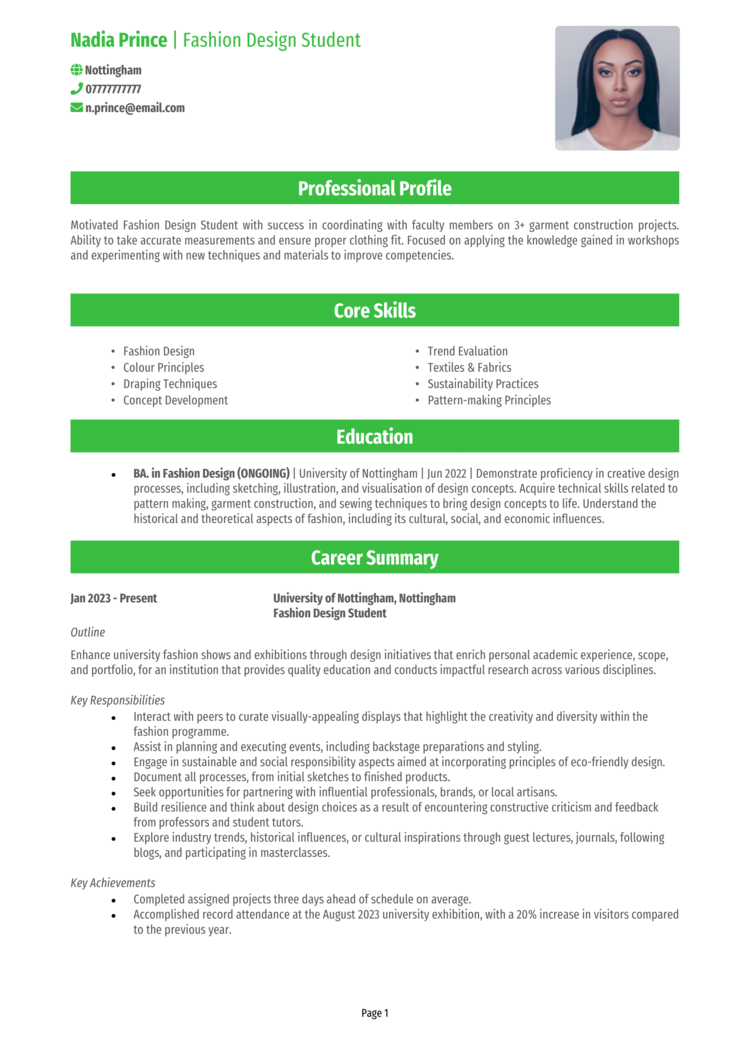
Fashion Assistant CV
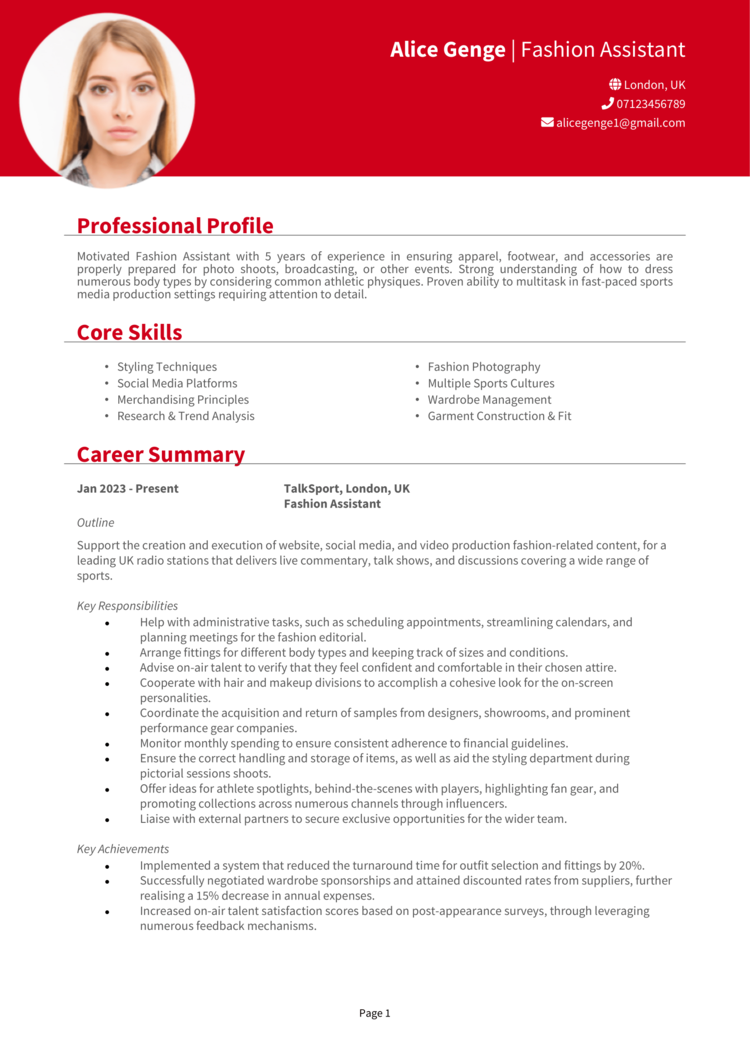
Fashion Editor CV
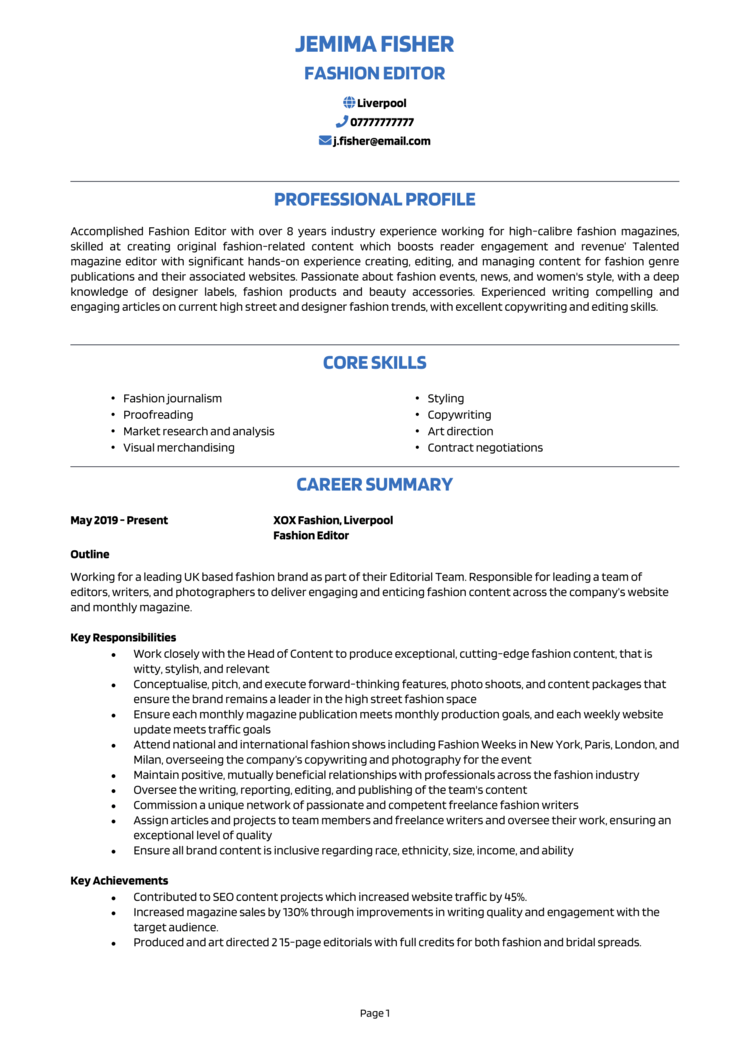
How to write your Fashion Designer CV
Learn how to create your own interview-winning Fashion Designer CV with this simple step-by-step guide.
A fashion designer’s CV should be as sleek and structured as a well-tailored garment. If it’s messy or poorly fitted to the job, hiring managers won’t waste time trying to ‘alter’ it.
This guide walks through each step of the process of writing your CV that presents your design skills as professionally as your best collection.
Fashion Designer CV structure


A recruiter should be able to scan your CV structure quickly and find the key information without unnecessary distractions. Think of it as a well-designed outfit – every element should be intentional, and there’s no room for mistakes. A clean and logically laid out CV ensures that your most relevant qualifications and experience stand out.
Here’s the structure to follow:
- Name and personal info – Put personal details at the top so employers can easily get in touch with you. A photo of yourself would generally be recommended for a fashion role.
- Profile – Start with a strong summary highlighting your expertise in fashion design, garment construction, and trend forecasting.
- Core skills – Provide a quick list of your most relevant technical and creative skills, such as pattern-making, fashion illustration, and textile selection.
- Work experience – Walk the recruiter through your past roles in reverse chronological order, detailing the brands or companies you’ve worked with and the impact of your designs.
- Education – Mention your degrees, certifications, and any training that supports your career path.
- Additional info – Include any additional details, like hobbies or memberships and awards, that highlight your skills or personality.
The correct format for a Fashion Designer CV


Presentation matters in fashion, and your CV formatting should reflect the same level of professionalism and attention to detail as your designs. If recruiters struggle to find key details, they may move on to the next applicant.
Always make sure you stick to these formatting principles:
- Bullet points – Break down your key information into skimmable bullet points for quick comprehension.
- Divide sections – Ensure each part of your CV is clearly defined with headings and consistent formatting.
- Use a clear and readable font – Opt for a clean, clear font to make your CV polished and easy to read.
- No more than 2 pages – Two pages is the ideal CV length to provide all the essential information while staying concise.
Fashion Designer CV profile


Your CV profile is like a brand statement – it should be bold, clear, and instantly tell recruiters what makes you stand out. This brief introduction at the top of your CV should summarise your expertise and the benefits hiring you would bring.
Tailor your profile to each job, ensuring it reflects what the employer is looking for.
Fashion Designer CV profile examples
Profile 1
Creative Fashion Designer with four years of experience designing contemporary womenswear collections for high-street brands. Skilled in trend forecasting, pattern making, and digital design using Adobe Illustrator and CLO 3D. Experienced in developing seasonal collections from concept to production, collaborating with suppliers, and ensuring alignment with brand identity. Passionate about creating innovative, market-ready designs that resonate with consumers.
Profile 2
Detail-oriented Fashion Designer with three years of experience in menswear, specialising in tailoring, technical construction, and fabric innovation. Proficient in CAD software, mood board creation, and garment prototyping. Experienced in working with manufacturers to develop high-quality, commercially successful designs. Dedicated to pushing creative boundaries while maintaining functionality and wearability.
Profile 3
Experienced Fashion Designer with over six years of expertise in luxury and couture fashion, focusing on intricate detailing, sustainable design, and bespoke garments. Skilled in draping, embroidery techniques, and working with high-end textiles. Adept at managing design projects, working with ateliers, and producing custom pieces for high-profile clients. Committed to craftsmanship and storytelling through design.
What to include in your Fashion Designer CV profile
A strong profile should consider the following helpful tips:
- Where you’ve worked – Mention whether you’ve worked in high fashion, commercial retail, costume design, or independent labels.
- Your top qualifications – If you have a degree in Fashion Design or Textile Design, highlight it here.
- Key fashion design skills – Whether it’s sketching, draping, or garment construction, highlight your strongest abilities.
- Industry knowledge – Demonstrate an understanding of current trends, sustainability, or branding if relevant.
- Technical expertise – Mention proficiency in tools like Adobe Illustrator, CLO 3D, or sewing and tailoring techniques.
How to present your core skills section properly


A core CV skills section allows recruiters to see your strongest abilities at a glance. It’s like a fabric swatch, giving recruiters a preview of what you bring to the table before they see the full collection. This section should be tailored to the specific role, ensuring that the skills listed match the job description.
Top skills for your Fashion Designer CV
- Trend Forecasting – Researching fashion trends, consumer behaviour, and market demands to inform design decisions.
- Sketching and Illustration – Creating hand-drawn or digital fashion sketches to visualise design concepts.
- Pattern Making – Developing accurate patterns for garments to ensure proper fit and structure.
- Textile Selection – Choosing fabrics, textures, and materials that complement design aesthetics and functionality.
- Garment Construction – Assembling prototypes and final pieces with precision in tailoring, stitching, and finishing.
- Draping Techniques – Manipulating fabric on a dress form to explore creative silhouettes and garment structures.
- Fashion CAD Software – Using tools like Adobe Illustrator, CLO 3D, or CorelDRAW to create technical drawings and digital mockups.
- Sustainability Practices – Integrating eco-friendly materials and ethical production methods into fashion design.
- Production Coordination – Overseeing manufacturing processes, quality control, and supply chain logistics.
- Brand Development – Establishing a unique design identity, including logo creation, packaging, and marketing strategy.
How to write a strong work experience section for your CV


Your work experience is the foundation of your CV. While listing skills is useful, recruiters want to see how you’ve applied them in a professional setting.
List your roles in reverse chronological order, starting with the most recent. If you have limited professional experience, highlight internships, fashion competitions, or freelance projects.
The best way to structure job entries on your CV

- Outline – Introduce the company or brand you worked for and the nature of your role within the team.
- Responsibilities – Describe your tasks, such as developing collections, working with manufacturers, or designing for specific client briefs. Use action words like “designed,” “illustrated,” and “constructed”.
- Achievements – Showcase measurable results where possible. Did your designs contribute to a best-selling collection? Were they featured in a major event or publication? Include tangible examples with numbers.
Example jobs for Fashion Designer
Fashion Designer | Urban Style Apparel
Outline
Designed trend-driven collections for a high-street fashion brand, managing the creative process from concept development to final production.
Responsibilities
- Conducted market research and trend forecasting to develop innovative and commercially viable designs.
- Created detailed technical sketches and spec sheets using Adobe Illustrator.
- Collaborated with pattern makers and garment technicians to refine fit and construction.
- Liaised with manufacturers to oversee sample development and production quality.
- Ensured designs aligned with seasonal brand identity and customer preferences.
Achievements
- Developed a bestselling capsule collection that increased brand sales by 30 percent.
- Reduced production costs by 15 percent by sourcing sustainable yet affordable materials.
- Recognised by senior management for delivering on-trend designs that exceeded sales projections.
Fashion Designer | TailorMade Menswear
Outline
Designed and developed tailored menswear collections for a luxury fashion house, ensuring high-quality craftsmanship and modern silhouettes that aligned with brand identity and market trends.
Responsibilities
- Created innovative and functional menswear pieces, focusing on fit and fabric performance.
- Worked closely with fabric suppliers to source materials that met design and cost requirements.
- Managed fittings and sample adjustments to maintain precision in garment construction.
- Developed CAD mockups and technical packages for manufacturers.
- Collaborated with marketing teams to ensure brand storytelling was integrated into designs.
Achievements
- Led the redesign of a signature suit collection, increasing sales by 20 percent.
- Improved garment durability and comfort through innovative textile selections.
- Received recognition for achieving a perfect balance of classic tailoring and modern trends.
Fashion Designer | Luxe Atelier Couture
Outline
Designed and handcrafted custom couture garments within an exclusive fashion atelier, working closely with high-profile clients to create one-of-a-kind pieces for red carpet events, weddings, and private commissions.
Responsibilities
- Developed intricate couture designs, focusing on hand embroidery, draping, and detailed embellishments.
- Worked one-on-one with high-profile clients to bring their vision to life.
- Managed the entire creative process, from sketching concepts to final fittings.
- Collaborated with skilled artisans and ateliers to execute complex design elements.
- Ensured all pieces adhered to the highest standards of craftsmanship and originality.
Achievements
- Designed a couture gown featured at a major fashion event, receiving media attention.
- Increased client base by 25 percent through referrals and brand recognition.
- Recognised for delivering exceptional detailing and innovative design approaches.
Education section


Your education section should highlight any formal training in fashion design, textiles, or related fields. While experience and portfolio matter most, relevant qualifications can strengthen your application.
If you’re early in your career, highlight relevant coursework, competitions, or design projects.
List your qualifications in reverse chronological order, starting with the most recent.
Qualifications recruiters look for in a Fashion Designer CV
- BA (Hons) Fashion Design – A widely recognised qualification that provides a strong foundation in garment construction, pattern-making, and design.
- MA in Fashion or Textiles – A postgraduate degree that helps designers refine their skills and develop industry connections.
- Diploma in Fashion Illustration or Digital Design – Useful for those focusing on fashion sketches, concept art, or digital rendering.
- Certification in Pattern Cutting and Garment Technology – Demonstrates expertise in tailoring, draping, and construction techniques.
- Adobe Illustrator and CAD Certification – Essential for designers working with digital fashion sketches and technical specifications.


